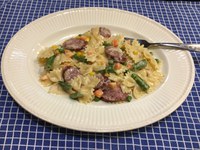Prairie Fare: Consider a Resolution to Recycle More Often
(Click an image below to view a high-resolution image that can be downloaded)
By Julie Garden-Robinson, Food and Nutrition Specialist
NDSU Extension
“Mom, I used to pull all-nighters to get projects done,” my older daughter said matter-of-factly. “We are going to finish this.”
I wanted to take a break from reorganizing our cupboards. My daughter was behaving more like she was my mother.
“But I’m tired,” I whined dramatically.
“You and Dad are hoarders,” she added as she threw plastic containers in the recycle bag.
“Are you taking my name in vain?” my husband asked as he poked his head in the kitchen.
I noted that he exited the kitchen rather abruptly. I was going to engage him in the kitchen cupboard deconstruction that was underway.
I didn’t realize that we were saving so many plastic items.
In the new year, I resolved to clean out the cupboard where we keep the storage containers. Now the project was taking on a life of its own.
Everything from the pantry and several other cupboards covered our countertops. We set up two card tables to help us with the food and container sorting process. We filled a large trash bag with plastic and glass items to be recycled.
Fortunately, we have order in the cupboards now. Even better, I won’t be greeted with a plastic avalanche when I pull open the pantry door.
We have a recycling program in our city, and we already recycle a lot of glass, cans and plastics. In addition, large bins that collect newspapers, magazines and flattened cardboard boxes are a short drive from our home.
Recycling is good for the environment, reduces the amount of waste going to landfills and saves money in the long run, among its many benefits.
Unfortunately, only 8.5% of plastics were recycled in the U.S. in 2018. About 35 million tons of plastic waste are generated annually, according to the Environmental Protection Agency (EPA).
If you have a recycling program available where you live, check out the local guidance. On the bottom of most plastic items, for example, you will find a number and the resin identification code in a triangular illustration.
For example, you might see “PETE” or “PET” next to a triangle with the No. 1 inside. That means that the resin used is polyethyleneterephthalate.
Isn’t PETE or PET a lot easier to pronounce?
Each number refers to a specific type of resin. High-density polyethylene, polyvinyl chloride and polypropylene are other common resins.
In community-based recycling programs, some but not all types of plastics might be recycled. The numbers help guide us. Local programs often specify the plastic numbers that are accepted, such as “plastics 1 to 7.”
On the other hand, glass can be reused and recycled repeatedly. About one-fourth of the 12.3 million tons of glass used in 2018 was recycled.
Glass is a safer storage material than plastic, according to many experts. At home, food in glass containers is easier to recognize. An added benefit: Glass will not take on the aroma or color of the food being stored.
Try these tips gleaned from the EPA website to help you reduce plastic waste:
- If you bring lunch to work, use reusable containers instead of disposable ones. Carry food in a reusable plastic or cloth bag. Use a reusable water bottle or thermos instead of disposable bottles for your beverages.
- If you use plastic bottles, recycle them instead of tossing them in the trash.
- Use reusable bags for groceries and other shopping trips, but check on the store’s policy.
- Check out https://epa.gov for more information and tips about recycling everything from paper to batteries to tires.
Our next project: We have a closet that spews plastic bags upon opening.
During the COVID-19 pandemic, we could not bring our own reusable bags into the grocery stores where we shop. Plastic bags typically are not allowed in curbside recycling bins. However, some grocery stores have bins for recycling plastic bags.
While exploring the recesses of our pantry, I found a lot of pasta. I made a family-favorite recipe. The original recipe was fairly high in fat. By using a reduced-fat sausage and half and half instead of heavy cream, the amount of fat and calories dropped significantly.
Creamy Sausage and Vegetable Alfredo
1 (12-ounce) ring bologna, reduced fat
8 ounces bowtie pasta or penne pasta, cooked according to package directions*
2 c. half and half (cream)
2 – 3 tsp. Cajun seasoning, to taste
1 (12-ounce) bag frozen mixed vegetables (such as corn, carrots, beans)
1/3 c. grated Parmesan cheese
Pepper, if desired
*Use whole-grain pasta if desired.
Prepare pasta according to directions. Slice sausage in 1/4-inch slices. In a large pot, saute sausage until lightly browned. Add half and half, seasoning and vegetables. Cook for about seven minutes, until vegetables are fully cooked and mixture begins to thicken. Note: If the sauce is not thick enough to your preference, add a commercial thickening agent such as “Wondra” according to the package instructions and continue cooking. Stir in Parmesan cheese. Add cooked pasta and toss well. Season with pepper if desired.
Makes eight servings. Each serving has 290 calories, 11 grams (g) fat, 15 g protein, 32 g carbohydrate, 3 g fiber and 730 milligrams sodium.
(Julie Garden-Robinson, Ph.D., R.D., L.R.D., is a North Dakota State University Extension food and nutrition specialist and professor in the Department of Health, Nutrition and Exercise Sciences. Follow her on Twitter @jgardenrobinson)
NDSU Agriculture Communication - Jan. 14, 2021
Source: Julie Garden-Robinson, 701-231-7187, julie.garden-robinson@ndsu.edu
Editor: Ellen Crawford, 701-231-5391, ellen.crawford@ndsu.edu




